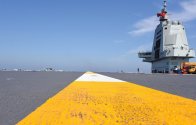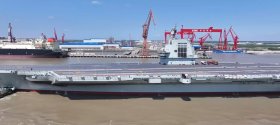You are using an out of date browser. It may not display this or other websites correctly.
You should upgrade or use an alternative browser.
You should upgrade or use an alternative browser.
CV-18 Fujian/003 CATOBAR carrier thread
- Thread starter Jeff Head
- Start date
Catapult does not consume that much power. For eg, Ford EMALS consume 121MJ per launch. Recharge time is 45 seconds. For one catapult that's about 2.72 megawatts sustained for 45 seconds.The ship 4 massive PAR and EM catobar consume a lot of electrical power.unless it was fitted with a small nuclear reactor to generate electrical power.
Well the trial officially lasted from the 1st to 8th of May, you should be able to find the image for the notification of the sea trial a few page back. As for the purpose of this round of sea trial:So how long was this first sea trial? Do we have any idea what they tested?
Aircraft Carrier CV-18 Fujian Maritime Trials Cover Measurements to Cabin Noise Exposure Levels to Crew & Light Effect on Human Vision
The ship 4 massive PAR and EM catobar consume a lot of electrical power.unless it was fitted with a small nuclear reactor to generate electrical power.
Power consumption:
Fujian has officially (per Wiki) 160MW power, which may or may not be only limited to the propulsion system. Fujian's 160 MW is 130% of QE-class (~120MW) at less than 125% of QE's displacement. Nimitz has four reactors producing heat for four steam turbines generating up to ~200MW for propulsion and ~100MW for electricity generation but usually only propulsion power is listed because it is what consumes most energy. Power is the amount of energy that can be produced within an unit of time. Higher power means a more energy in less time. But how much energy is needed is determined by many other - often very simple mechanical - constraints.
A lot of the ships electric power is used for elevators and aircraft service stations during high-tempo operations. Current USN air wing has up to 55 fighters, 5 AEW and 20 helos and three (four in older) elevators . Fujian has (per Wiki) up to 40 fighters, 4 AEW and 12 helicopters and two elevators. That's 72% of fighters and 60% of helos and 50-66% elevators. Op-tempo is also lower on Fujian so total energy required is lower.
Nuclear powerplant also needs to have greater power output because if anything goes wrong it often must be shut down completely and can't be fixed outside of a port facility. This is not true for traditional power plants which means that greater reserve is necessary for nuclear systems.
Catapults:
Electromagnetic catapult is significantly more efficient than steam catapult. A lot of energy in steam catapults is lost to heat loss since steam generates force with pressure and pressure and temperature are described by PV=T relationship. The physical process of force generation in steam and EM catapults is like hammer vs screwdriver. EM's energy output is smooth and flexible depending on what is being launched while steam catapults work with very crude discrete levels so there's further loss of energy on that. Compared to a steam device you can do more with less and better if you have EM catapult. Someone else can perhaps cite the relevant numbers. I don't have them at hand right now but compared to steam EM saves energy in all areas.
Radars:
Phased array architecture is not actually correlated with a power requirement. It is merely a coincidence resulting from the fact that wave mechanics is directly influenced by the energy of the wave and therefore having greater wave energy i.e. higher radar power is always better. However higher power has also diminishing marginal gain per unit of power due to the geometrical nature of spherical wave mechanics. At certain distances it becomes impractical to continue to increase power of a single beam because the strength of the signal is the means to an end and not the end in itself. It is meant to provide strong return on signal so that the image i.e. information gained is better. But information can be gained both by increasing signal power as well as receiver sensitivity i.e. antenna/array gain and mathematically greater sensitivity beats greater power in information acqusition. Phased arrays provide better sensitivity.
Phased arrays were introduced because they provide better resolution and better refresh rates which means that higher power of the signal is not wasted as it would be the case with traditional antenna design. A simple linear antenna can have power in GW and range in thousands of kms but it will have a resolution measured in kms as well because this resolution will be determined by the size of the beam/main lobe and the frequency of beam generation. Radar beams are like electromagnetic fingers that "feel" the target. Having more smaller fingers is better than having one big finger.
Phased arrays are also a method of beam forming not power scaling. Whenever discussing traditional radars vs PAR the focus should be on the "electronically scanned" as opposed to "mechanically scanned". Phase-shifting is just the technological solution that enables electronic scanning using a single signal generator which is how all mechanically scanned radars were built (because each singal requires its own processing unit).
I would put it like this: traditional radars are to phased arrays as radio is to tv.
In reality having phased array radars doesn't mean that the radars will operate at maximum power or at significantly greater power levels than traditional radars. Phased arrays are simply better because of the flexibility they provide. In terms of OPSEC keeping the signature at minimum is always optimal and since ship-based radars are less capable than airborne radars for majority of tasks I assume Fujian will rarely use its radar to the maximum.
I expect Fujian will be using its radar in the manner that recent developments in that field suggest i.e. for managing of immediate airspace and launch/recovery and will provide only backup in case KJ-600 or escorts are unavailable.
All in all I think that by rule of thumb the power installed is just about right.
Let's not forget that Fujian is by design a "small supercarrier" and not the equivalent of "large supercarrier" like Nimitz or Ford. I probably should not even use the term "supercarrier" as in operational terms Fujian is closer to de Gaulle than to Nimitz, let alone Ford. Displacement or size of deck is not the only thing that matters.
It is a popular missunderstanding that conventional CV lack the electrical generation capability due to EM cat (hence EM cat must use nuclear).The ship 4 massive PAR and EM catobar consume a lot of electrical power.unless it was fitted with a small nuclear reactor to generate electrical power.
EM cat gets its power in the form of electricity through generator driven by steam turbine which gets its steam from the boiler. Steam cat gets its energy directly from the the boiler. The input is all the same, steam from the boiler. The only difference is the heat source. Although steam to electricity convertion will waste a little energy, it is much much less loss than steam cat. In the end, EM cat consumes less energy (volume of steam) than steam cat. Therefor, EM cat does absolutely NOT need a nuclear power plant. This has been repeatedly talked about in this forum.
The energy savings from using EM cat may well compansate the increase demand from the radar.
It is a popular missunderstanding that conventional CV lack the electrical generation capability due to EM cat (hence EM cat must use nuclear).
EM cat gets its power in the form of electricity through generator driven by steam turbine which gets its steam from the boiler. Steam cat gets its energy directly from the the boiler. The input is all the same, steam from the boiler. The only difference is the heat source. Although steam to electricity convertion will waste a little energy, it is much much less loss than steam cat. In the end, EM cat consumes less energy (volume of steam) than steam cat. Therefor, EM cat does absolutely NOT need a nuclear power plant. This has been repeatedly talked about in this forum.
The energy savings from using EM cat may well compansate the increase demand from the radar.
In the case of CV-18, electrical energy is also provided by dedicated auxiliary genset units which it has anyway, so the strain on steam turbines should be even less. That is to say, I expect power shouldn't be an issue in terms of supplying the steam turbine itself for propulsion and electrical power for subsystems and EM catapults (from gensets and the steam turbines both)
Nuclear reactors do not have a higher PWR (power to weight ratio) than ICE (internal combustion engines). If that were the case then we'd have nuclear powered jet planes.The ship 4 massive PAR and EM catobar consume a lot of electrical power.unless it was fitted with a small nuclear reactor to generate electrical power.
Nuclear reactors give you more energy not power.


